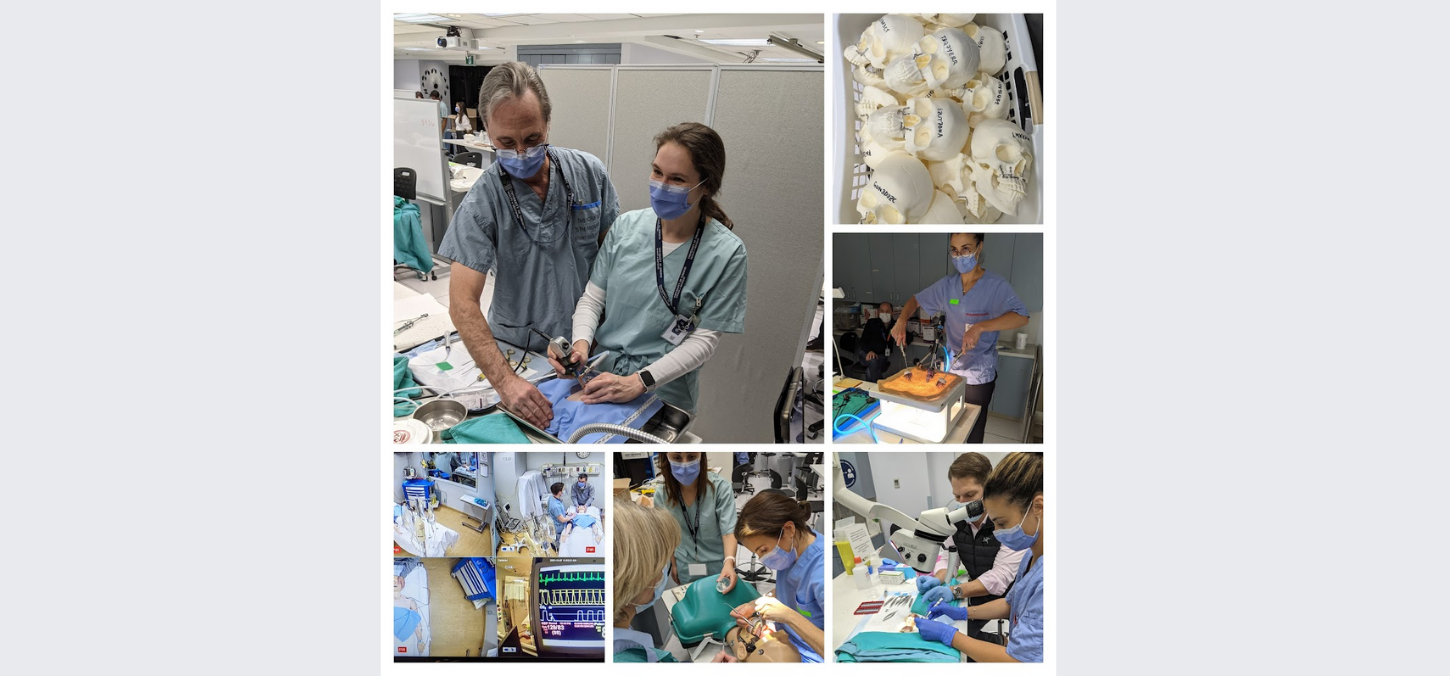
Third annual exam puts technical skills to the test
By Rachel Boutet
On November 7, oral and maxillofacial surgery (OMFS) residents from across North America participated in a research project called the Oral & Maxillofacial Objective Structured Assessment of Technical Skills (OMOSATS) exam. Although called a technical skills “exam”, the main focus of the exercise is to ensure that residents (and their teaching programs) can perform surgery within the parameters outlined in the CanMeds 2015 framework. The exam took place at the University of Toronto Surgical Skills lab located at Mount Sinai Hospital.
This endeavor was led by Dr. Marco Caminiti 9T8 Dip OMFS, assistant professor and graduate program director of OMFS at the Faculty of Dentistry, and Dr. Mark Shuren, a trauma surgeon at Hotel Dieu Hospital, Windsor Ontario. Participating residents rotated through eight stations where they were allotted 12 minutes to perform specific surgical tasks. The exam is the technical skills version of the common and well-known bell ringer OSCE (Objective Structured Clinical Exam). This third iteration of the exam was cancelled last year due to the COVID-19 pandemic and Caminiti wanted to ensure it was not delayed another year.
“When we were planning in August, we knew we were risking the pandemic restrictions,” says Caminiti. “Luckily, timing worked in our favour and we were again able to run the exam – the only type of its kind in oral surgery.”
Funding for the exam was provided by a grant Caminiti received from the American Oral and Maxillofacial Surgery Foundation. Lisa Satterthwaite, senior manager, at the Surgical Skills and SimSinai Centre, was one of the collaborators for the exam. Her team reviewed the format, timing and station needs for the exam and provided the space – the Surgical Skills Centre – which this year included the SimSinai Centre to the exam to allow for a human patient simulation station.
“The goal of the exam is to help residents recognize areas they need improvement and gain comfort in areas they are excelling in”
The participating residents joined from the University of Toronto as well as other Canadian and American OMFS residency programs with varying skill levels and expertise. Although the specifics of the exam were not known to residents ahead of time, they were built based on the skills they practice during their studies.
The stations were designed to present potential patient cases and have residents perform the required surgeries, including: a tracheostomy, a sinus lift and implant placement on a dummy model, a plate bending test commonly used for facial deformities, a microneurosurgical station, a laparotomy station testing endoscopic skills, a temporomandibular joint arthroscopy station and a cleft palate simulation. The exam also gave residents the opportunity to showcase their skills to some of the top surgeons in the world who make up the examiners panel. The examiners were content experts from across the country who were blinded to the level of residency of the candidates. The marking was based on task specific checklists and a validated global rating scale.
“The goal of the exam is to help residents recognize areas they need improvement and gain comfort in areas they are excelling in,” says Caminiti. “Then, as program directors, we can make adjustments to our teaching, spending more time where students require additional practice. In a sense, the OMOSATS mirrors how well we are teaching – or where we might be lacking.”
Satterthwaite agrees. “It’s important to show residents that we value their educational needs and aim to remediate skills in a non-punitive fashion to help them meet their goals, and offer one-on-one direct feedback to support knowledge-based learning,” she says. “Great patient outcomes is our ultimate goal.”
Caminiti says the day would not have been possible without the help of the content expert examiners who volunteered their weekend to be with the residents. Most importantly, the hard work of volunteer DDS students, including Pegi Kaimi, Class of 2024, Freddy Kersi Mistry, Class of 2022, Suraya Dhalla, Class of 2023, Shawn Zahavi, Class of 2024, Matthew Reyad, Class of 2024, Jade Goodman, Class of 2024 and Amanda Tittel, Class of 2024, made a huge difference. Victoria Driesman, a medical student at the University of Rochester, also worked closely with the DDS students and was key in administering the previous two exams.
“I started working with Dr. Caminiti after I was assigned to a research role in OMFS,” says Kaimi. “I wanted to get involved in OMOSATS because I was very curious about oral and maxillofacial surgery and thought it would be a great opportunity to learn about the different procedures. It’s been fascinating to learn about the scope of the program.”
Kaimi says this experience has solidified her interest in pursuing a graduate degree in OMFS at the Faculty.
Photo: a sampling of the tasks examined during the 2021 administration of the OMOSATS. Clockwise from upper left: Dr. David Psutka, attending surgeon 7T9, with dental student Amanda Tittel (DDS Class of 2023) testing out the TMJ Arthroscopy station; a sample of plastic skulls used for facial osteotomy rigid fixation application; OMFS resident Dr. Amina Bouzid (OMFS Class of 2023) being tested on endoscopy skills; Amina being observed by Dr. Michael Markiewicz DDS, MD, MPH (visiting professor from University of Buffalo) on microsurgical skills; Dr. Maria Franco MD DDS MSc (DSATP resident) demonstrating her sinus grafting and implant skills to Dr. Julia Pompura (9T6 OMFS) and dental student Suraya Dhalla (DDS Class of 2023); and a screen shot of the Simulated Patient station at SimSinai lab. (Taken by Marco Caminiti)